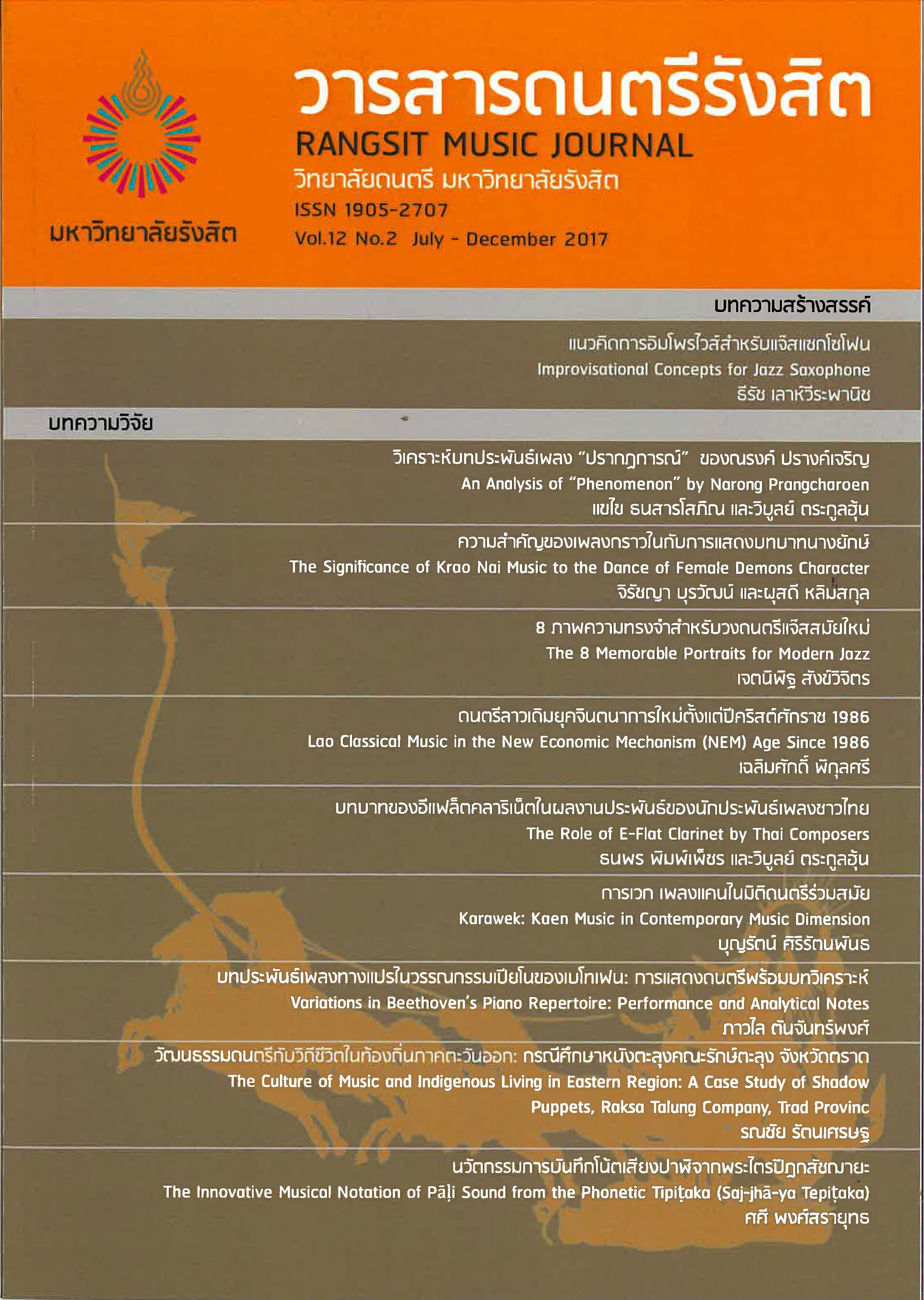The Innovative Musical Notation of Pāḷi Sound from the Phonetic Tipiṭaka (Saj-jhā-ya Tepiṭaka)
Keywords:
Pali, Buddhism, Tipitaka, Musical NotationAbstract
The Innovative Musical Notation of Pāḷi Sound from the Phonetic Tipiṭaka (Sajjhā-ya Tepiṭaka) transformed Pāḷi phonetics into musical notes and the standard western notation method. Precise writing of Pāḷi sound, according to the Pāḷi phonetics system, led to the integration between linguistics and musicology. The results were Pāḷi notation and the international standard note notation method. Reciting Saj-jhā-ya according to this Pāḷi notation method will bring in harmony and punctuality as a standard of group chanting. Moreover, it can interpret all the Pāḷi sounds in the Tepiṭaka which written with at least 20 million different alphabets in 40 books. The innovative musical notation for Pāḷi sound is an integration of many fields of study; Tepiṭaka, linguistics, Pāḷi language, Buddhism and musicology. This breakthrough innovation is for studying and practicing to improve the recitation of Sajjhā-ya sound. Also, it is for conserving the sound of Pāḷi. To broaden the civilization which inherited by sound to international stage. This innovation is not only change the pattern of sound writing but also pave a way to a new dimension of Pāḷi phonetics. It makes Pāḷi easier to understand and to study. In short, the readers can clearly recite Pāḷi words and, later, form a great meditation which is the goal and good deeds of this modern Pāḷi recitation.
References
2. ชิดชนก เหลือสินทรัพย์. “กฎการตัดพยางค์จากคำที่เขียนด้วยอักขรสยาม-ปาฬิเพื่อการอ่านออก เสียงโดยอัตโนมัติ.” ใน หนังสือที่ระลึก 80 ปี ราชบัณฑิตยสถาน. บรรณาธิการ ราชบัณฑิตสถาน, หน้า 483. กรุงเทพฯ: อรุณการพิมพ์, 2557.
3. ณัชชา พันธุ์เจริญ. พจนานุกรมศัพท์ดุริยางคศิลป์. พิมพ์ครั้งที่ 4. กรุงเทพฯ: เกศกะรัต, 2554.
4. ธัมมจักกัปปวัตตน วรรคที่ 2 ตถาคตสูตรที่ 1 พระไตรปิฎก เล่มที่ 19. พระไตรปิฎกปาฬิ “จุลจอมเกล้าบรมธัมมิกมหาราช” ร.ศ.112 อักขะระสยาม (39 เล่ม). กรุงเทพฯ: มปท., 2436.
5. พระไตรปิฎกปาฬิ “สยามรัฐ” อักขะระไทย (45 เล่ม). กรุงเทพฯ: โรงพิมพ์มหามกุฎราชวิทยาลัย, 2536.
6. สุรธัช บุนนาค และสุชาติ วงศ์เกียรติขจร. “กระบวนการตัดพยางค์ คำปาฬิ-อักขระสยามเป็นพยางค์ เพื่อการอ่านออกเสียงปาฬิในอุปกรณ์อิเล็กทรอนิกส์.” สิทธิบัตรหมายเลข 1401005547. วิจินตน์ ภาณุพงศ์. “สัททอักษรไทยปาฬิ.” วารสารราชบัณฑิตยสถาน, 37(2) 2555: 247-263.
7. Apel, Willi. The Notation of Polyphonic Music 900-1600. 5th ed. Cambridge, MA: Medieval Academy of America, 1961.
8. Cole, Hugo. Sounds and Signs: Aspects of Musical Notation. London: Oxford UP, 1974.
9. MacGrain, Mark. Music Notation: Theory and Technique for Music Notation. Boston: Berklee Press, 1986.
10. Parrish, Carl. The Notation of Medieval Music. New York: Carl Fisher, Inc., 1946.
11. Read, Gardner. Music Notation: A Manual of Modern Practice. Boston: Crescendo Publishers, 1969.
12. Saulnier, Daniel. Gregorian Chant: A Guide to the History and Liturgy. Orleans, MA: Paraclete Press, 2009.
13. Stone, Kurt. Music Notation in the Twentieth Century. New York: Norton, 2009.
Downloads
Published
How to Cite
Issue
Section
License
กองบรรณาธิการฯ สงวนสิทธิ์ในการพิจารณาและตอบรับการตีพิมพ์ ความรับผิดชอบใดๆ เกี่ยวกับเนื้อหาและความคิดเห็นในบทความเป็นของผู้เขียนต่อบทความนั้นๆ กองบรรณาธิการฯ ไม่ต้องรับผิดชอบ



